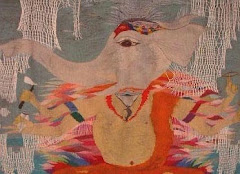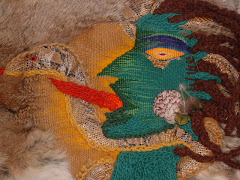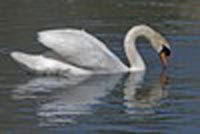
Chapter Six
Amritapuri, India
4,000 of us Westerners and Indians walk three kilometers in two single-file lines down the ocean road to the site of the mass cremation. It is the sixteenth and last day of the daily funeral rites after the tsunami. As we walk we chant a prayer for the peace and well-being of the world. At the beach, forty-two palm frond lean-tos cover the ashes where pyres burned. Amma leads the rites. Holding clay oil lamps in our palms, we circumambulate the funeral site, praying for the living and the dead all over the world.
Amma speaks to everyone: “We may claim that we are the ones who are doing everything, but before we could even blink our eyes, the waves came and destroyed everything…One thing we can do in this situation is to invoke love and compassion in our hearts. Pray with your hearts. Act with your hands. The dead are gone. To bring them back is impossible. Let us use this situation an opportunity to share peace and love with the living.”
Ankle-deep in water, we place lighted lamps onto lapping waves and watch the tide carry them away. One fisherman tells Amma he's become frightened of the water; she helps him gather courage by inspiring him to wade out chest-deep where he offers his lamp to the sea.
In the days and months to follow, beyond restoring lives through construction of new homes and boats, feeding thousands a day, replenishing necessities, offering medical aid, and providing vocational training, there was more. There was the rekindling of spirit.
Amma and several Westerners taught thousands of children to swim so they would not fear the water. Many women and children who died in the 2004 Asian tsunami had not known how to swim. The lessons took place in the swimming pool during several 3-day yoga camps held in the ashram. Children learned about their cultural heritage, Indian philosophy, how to cultivate optimistic thinking, and to practice yoga and meditation. They also enjoyed play-time, including how to make paper airplanes and then sending hundreds gliding from upper floors of the ashram.
To help children in the temporary shelters catch up with school work, the ashram arranged tutoring classes and provided school materials.
Over several years before the tsunami, quite a few villagers had abandoned their tradition of singing devotional songs at sunrise and sunset, in favor of watching TV. Most took up their spiritual practices again following the devastation. To help villagers revitalize their faith, a couple of ashram monks would ride bikes up and down the coast, stopping to give inspirational talks and lead the people in chanting.
Psychologists from Amma’s hospital in Cochin visited villages to offer music and art therapy, to help alleviate and heal post traumatic stress. Adult villagers composed hymns and lyrics, expressing their feelings and experiences. Children drew pictures of clinging to the tops of palm trees, floating under water, struggling in the wave, and of homes submerged with fish all around.
The children and adults were encouraged to talk about what happened. In addition, ashram residents visited temporary relief housing projects daily to play sports with children and to sing devotional songs with them. The community-style living and lighthearted activities that went on in and around the temporary shelters helped people heal emotionally and to remember what it was like to feel happy.
The ashram psychologists attributed the rapid emotional, psychological, and spiritual recovery to this re-creation of community and human connection that went on the shelters. These people who had lost everything, had the wealth of community.
Spiritual and psychological rehabilitation programs conducted by many organizations, took place all over tsunami-torn Asia.
Amma speaks to everyone: “We may claim that we are the ones who are doing everything, but before we could even blink our eyes, the waves came and destroyed everything…One thing we can do in this situation is to invoke love and compassion in our hearts. Pray with your hearts. Act with your hands. The dead are gone. To bring them back is impossible. Let us use this situation an opportunity to share peace and love with the living.”
Ankle-deep in water, we place lighted lamps onto lapping waves and watch the tide carry them away. One fisherman tells Amma he's become frightened of the water; she helps him gather courage by inspiring him to wade out chest-deep where he offers his lamp to the sea.
In the days and months to follow, beyond restoring lives through construction of new homes and boats, feeding thousands a day, replenishing necessities, offering medical aid, and providing vocational training, there was more. There was the rekindling of spirit.
Amma and several Westerners taught thousands of children to swim so they would not fear the water. Many women and children who died in the 2004 Asian tsunami had not known how to swim. The lessons took place in the swimming pool during several 3-day yoga camps held in the ashram. Children learned about their cultural heritage, Indian philosophy, how to cultivate optimistic thinking, and to practice yoga and meditation. They also enjoyed play-time, including how to make paper airplanes and then sending hundreds gliding from upper floors of the ashram.
To help children in the temporary shelters catch up with school work, the ashram arranged tutoring classes and provided school materials.
Over several years before the tsunami, quite a few villagers had abandoned their tradition of singing devotional songs at sunrise and sunset, in favor of watching TV. Most took up their spiritual practices again following the devastation. To help villagers revitalize their faith, a couple of ashram monks would ride bikes up and down the coast, stopping to give inspirational talks and lead the people in chanting.
Psychologists from Amma’s hospital in Cochin visited villages to offer music and art therapy, to help alleviate and heal post traumatic stress. Adult villagers composed hymns and lyrics, expressing their feelings and experiences. Children drew pictures of clinging to the tops of palm trees, floating under water, struggling in the wave, and of homes submerged with fish all around.
The children and adults were encouraged to talk about what happened. In addition, ashram residents visited temporary relief housing projects daily to play sports with children and to sing devotional songs with them. The community-style living and lighthearted activities that went on in and around the temporary shelters helped people heal emotionally and to remember what it was like to feel happy.
The ashram psychologists attributed the rapid emotional, psychological, and spiritual recovery to this re-creation of community and human connection that went on the shelters. These people who had lost everything, had the wealth of community.
Spiritual and psychological rehabilitation programs conducted by many organizations, took place all over tsunami-torn Asia.
In contrast to the above stories of tsunami relief, are these from Hurricane Katrina:
New Orleans, August 31, 2005. Excerpts from CNN.com
…three shootings, widespread looting and a number of attempted carjackings had been reported near the Louisiana Superdome, where more than 20,000 people were holed up in the city's shelter of last resort, where toilets were overflowing and there was no air conditioning to provide relief from 90-degree heat. Bathrooms had no lights, making people afraid to enter, and the stench from backed-up toilets inside killed any inclination toward bravery.
“When we have to go to the bathroom we just get a box. That’s all you can do now,” said Sandra Jones.
From the Associated Press, Sept 3, 200
Evacuations of the last remaining refugees at the arena were halted before dawn Saturday …The Texas Air National Guard estimated that between 2,000 and 5,000 people remained at the Superdome on Saturday amid a frightening scene of filth, violence and despair.
The last 300 refugees in the Superdome climbed aboard buses Saturday bound for new temporary shelter, leaving behind a darkened and stinking arena strewn with up to five feet of trash.
The sight of the last person — an elderly man wearing a Houston Rockets cap — prompted cheers from members of the Texas National Guard who were guarding the facility. “I feel like I’ve been here 40 years,” said Louis Dalmas Sr., one of the last people out. “Any bus going anywhere — that’s all I want.”
Conclusion:
In this, the wealthiest nation in the world, we witnessed in New Orleans, man's capacity for inhumanity to man.
Our American leaders did not know how to organize a practical and dignified solution for the simple matter of food and shelter, nor how to inspire connection to root traditions and spirit in ways that would use the fertile ground of tragedy to raise the human spirit, to give hope for the future.
In India, the lotus flower, symbol of spirituality and beauty, has its roots growing out of mud and garbage. All over Asia, tsunami relief efforts, efforts suitable to local culture and community, demonstrated how transformation can rise out of the mud of calamity.
Credits:
Photo:http://www.flickr.com/
cherry965 photostream
Amma quote: Amma and the Tsunami: Pray & Serve (MA Center, San Ramon, CA, 2007)
Our American leaders did not know how to organize a practical and dignified solution for the simple matter of food and shelter, nor how to inspire connection to root traditions and spirit in ways that would use the fertile ground of tragedy to raise the human spirit, to give hope for the future.
In India, the lotus flower, symbol of spirituality and beauty, has its roots growing out of mud and garbage. All over Asia, tsunami relief efforts, efforts suitable to local culture and community, demonstrated how transformation can rise out of the mud of calamity.
Credits:
Photo:http://www.flickr.com/
cherry965 photostream
Amma quote: Amma and the Tsunami: Pray & Serve (MA Center, San Ramon, CA, 2007)







No comments:
Post a Comment